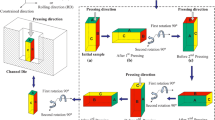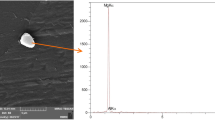Abstract
Over the last half century, vibratory stress relief (VSR) has come to be recognized as a technique with several unique benefits, and it has found applications in various industries. However, the mechanisms involved remain unclear, and the textures corresponding to residual stress relaxation were rarely reported in the existing literature. The purpose of this study is to discuss the texture evolution and residual stress relaxation in a cold-rolled Al-Mg-Si-Cu alloy using VSR technique. All the residual stress measurements were performed using a standard X-ray diffraction (XRD) technique. Measurement of texture was performed on the specimen surface using conventional pole figure (PF) as well as orientation distribution functions (ODFs) methods. Results indicate that the VSR technique can be applied to weaken the α-fiber and cause the residual stress of the rolled samples to gradually approach uniformity in XRD analysis. The best relaxation of the compressive residual stress reaches about 52.6 pct, but relaxation of the tensile residual stress is less than 10 pct. After the VSR process for 20 minutes, the texture intensities of PFs (200) and (220) as compared to those in nonvibration are nearly homogeneously distributed. Furthermore, the texture of (111) PF perpendicular to normal direction (ND), which is affected by vibratory force parallel to ND, almost disappears.











Similar content being viewed by others
References
M.C. Sun, Y.H. Sun, and R.K. Wang: Mater. Lett., 2004, vol. 58, pp. 1396-99.
D. Rao, J. Ge, and L. Chen: J. Manuf. Sci. Eng., 2004, vol. 126, pp. 388-91.
C.W. Kuo, S.M. Yang, J.H. Chen, G.H. Lai, Y.C. Chen, Y.T. Chang and W. Wu: Mater. Lett., 2008, vol. 49(3), pp. 688-90.
S. Kwofie: Mater. Sci. Eng. A, 2009, vol. 516, pp. 154-61.
G. Gnirss: Indian Weld. J., 1990, vol. 22, pp. 11-16.
R. Dawson and D. G. Moffat. J: Eng. Mater. Technol. Trans. ASME., 1980, vol. 102, pp. 169-76.
G. Hebel, Jr.: Met. Prog., 1985, vol. 128, pp. 51-55.
E. Klotzbucher and H. Kraft: Residual Stresses in Science and Technology, 1st ed., DGM Metallurgy Information, 1987, p. 959.
J.T. Maximo, G.V. Dunchev, and I.N. Mitev: J. Constr. Steel Res.., 2009, vol. 65, no. 3, pp. 909-17.
J. Liu and J.G. Morris: Metall. Mater. Trans. A, 2003, vol. 34A, pp. 951-66.
O. Engler and J. Hirsch: Mater. Sci. Eng. A, 2002, vol. 336, pp. 249-62.
S.C. Xu, L.D. Wang, P.T. Zhao, W.L. Li, Z.W. Xue, and W.D. Fei: Mater. Sci. Eng. A, 2011, vol. 528, pp. 3243-48.
Y. Kaneno, I. Nakaaki, and T. Takasugi (2002). Intermetallics, 10, 693-700.
V. Randle and O. Engler: Introduction to Texture Analysis, 2nd ed., CRC Press, Boca Raton, 2010, pp. 149–50.
C.S.T. Chang and B.J. Duggan: Acta Mater., 2010, vol. 58, pp. 476-89.
Y. Takayama and J. A. Szpunar: Mater. Trans., 2004, vol. 45, no. 7, pp. 2316-25.
Y.L. Deng, L. Wan, Y. Zhang, and X.M. Zhang: J. Alloys Compd., 2010, vol. 498, pp. 88-94.
A.L. Etter, T. Baudin, M.H. Mathon, W. Swiatnicki,and R. Penelle: Scripta Mater., 2006, vol. 54, pp. 683-88.
J.M. Song, T.S. Lui, J.H. Horng, L.H. Chen, and T.F. Chen: Scripta Mater., 2004, vol. 51, pp. 1153-57.
C.W. Kuo, C.M. Lin, G.H. Lai, Y.C. Chen, Y.T. Chang, and W. Wu: Mater. Trans., 2007, vol. 48 (9), pp. 2319–23.
P. Juijerm, I. Altenberger, and B. Scholtes: Mater. Sci. Eng. A, 2006, vol. 426, pp. 4-10.
H. Holzapfel, V. Schulze, O. Vöhringer, and E. Macherauch: Mater. Sci. Eng. A, 1998, vol. 248, pp. 9-18.
D. Rao, D. Wang, L. Chen, and C. Ni: Int. J. Fatigue, 2007, vol. 29, pp. 192–96.
Z. A. Yang and Z. G. Wang: Mater. Trans., 1991, vol. 142, pp. 25-33.
Z.-L. Zhan and J. Tong: Mech. Mater., 2007, vol. 39, pp. 73-80.
H.D. Chandler and S. Kwofie: Int. J. Fatigue, 2005, vol. 27, pp. 541-45.
H.D. Chandler: Acta Metall, 1984, vol. 32, no. 8, pp. 1253–57.
D. J. Buchanan and R. John: Scripta Mater., 2008, vol. 59, pp. 286-89.
I. Nikitin and M. Besel: Scripta Mater., 2008, vol. 58, pp. 239-42.
B.D. Cullity: Elements of X-Ray Diffraction, 2nd ed., Addison Wesley, London, 1978, pp. 285–92.
B.D. Cullity and S.R. Stock: Elements of X-Ray Diffraction, 3rd ed., Prentice-Hall, Upper Saddle River, 2001, pp. 446–50.
X. Huang, K. Suzuki, and Y. Chino: Mater. Sci. Eng. A, 2012, vol. 538, pp. 281-87.
U.F. Kocks, C.N. Tomé, and H.R. Wenk: Texture and Anisotropy, 1st ed., Cambridge University Press, Cambridge, 1998.
Acknowledgment
This study was partially supported by the National Science Council, Taiwan, R.O.C., under the project NSC 99-2221-E-005-033-MY3.
Author information
Authors and Affiliations
Corresponding author
Additional information
Manuscript submitted May 14, 2012.
Rights and permissions
About this article
Cite this article
Wang, JS., Hsieh, CC., Lin, CM. et al. Texture Evolution and Residual Stress Relaxation in a Cold-Rolled Al-Mg-Si-Cu Alloy Using Vibratory Stress Relief Technique. Metall Mater Trans A 44, 806–818 (2013). https://doi.org/10.1007/s11661-012-1450-8
Published:
Issue Date:
DOI: https://doi.org/10.1007/s11661-012-1450-8




